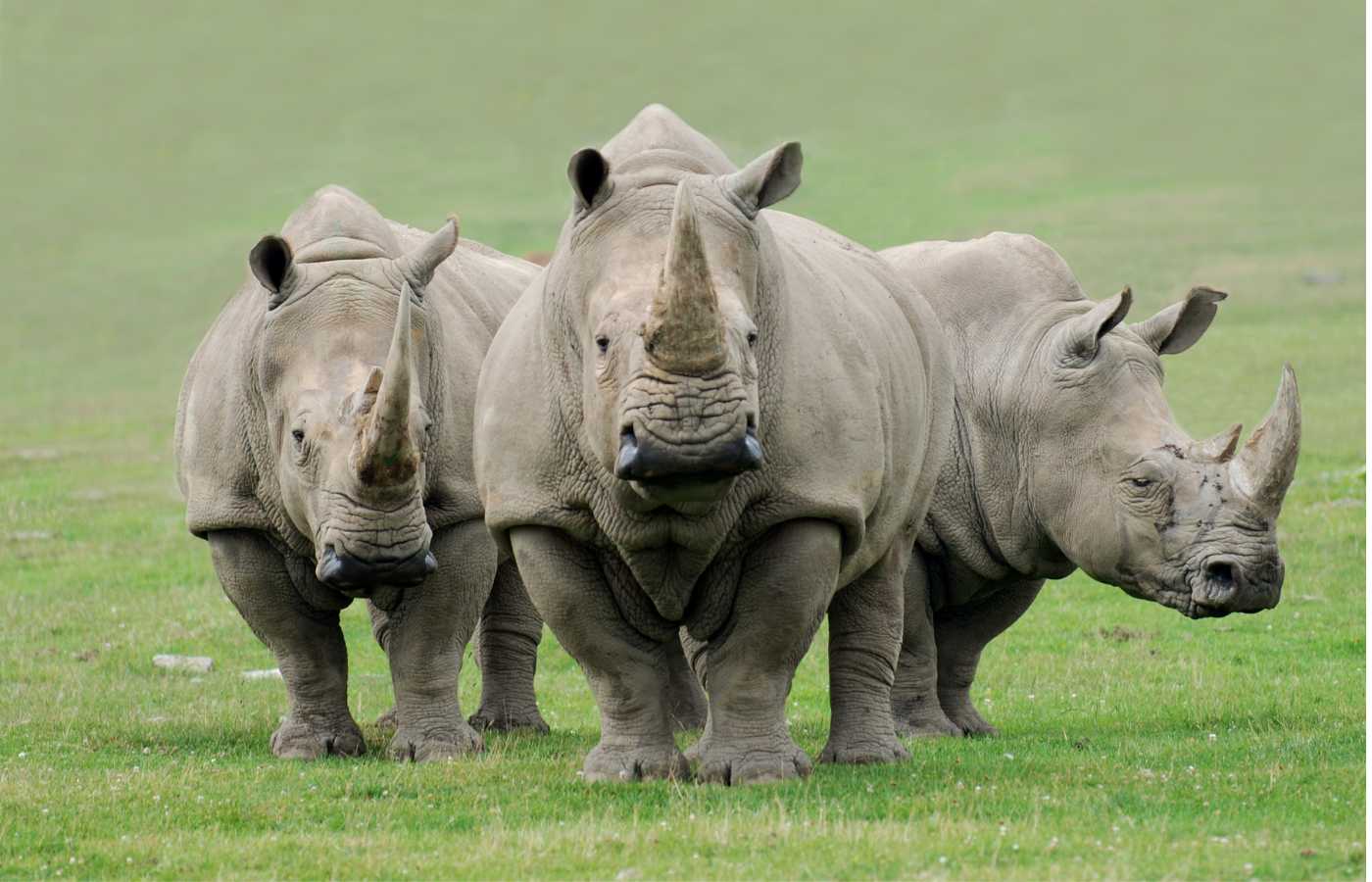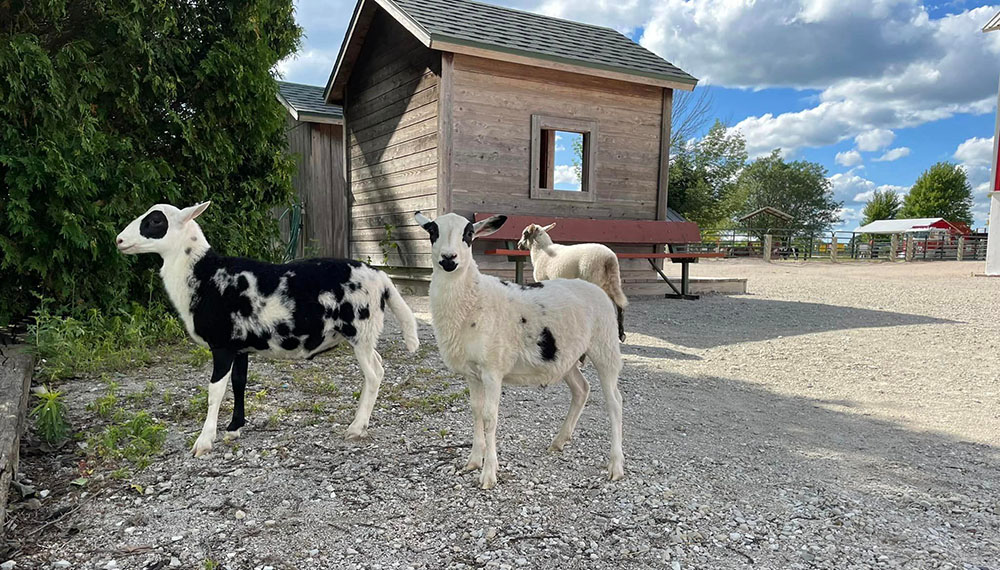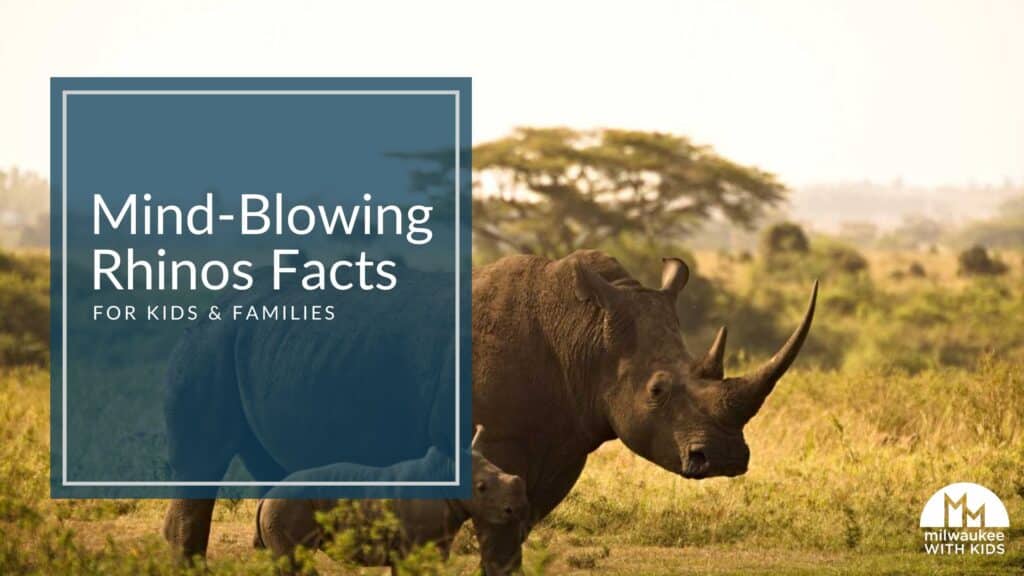
World Rhino Day is celebrated on September 22nd, and it’s the perfect time to learn more about these incredible giant mammals.
Here are some interesting rhinos facts for kids that will blow your minds! To help in the conservation efforts to protect this endangered species, head to rhinos.org.
SIZE
- White Rhinos can weigh over 7,500 pounds! They are the largest rhino species. (Source: www.wwf.org.uk) Sumatran Rhinos are the smallest of all the species, and they can still weigh over 1,300 pounds. (Source: www.wwf.org.uk)
- White Rhinos are the second largest land mammal in the world. Only elephants are bigger than White Rhinos. (Source: kids.nationalgeographic.com) Want to learn more about the largest land animal? Dive into our Elephant Facts For Kids to discover amazing elephant trivia.
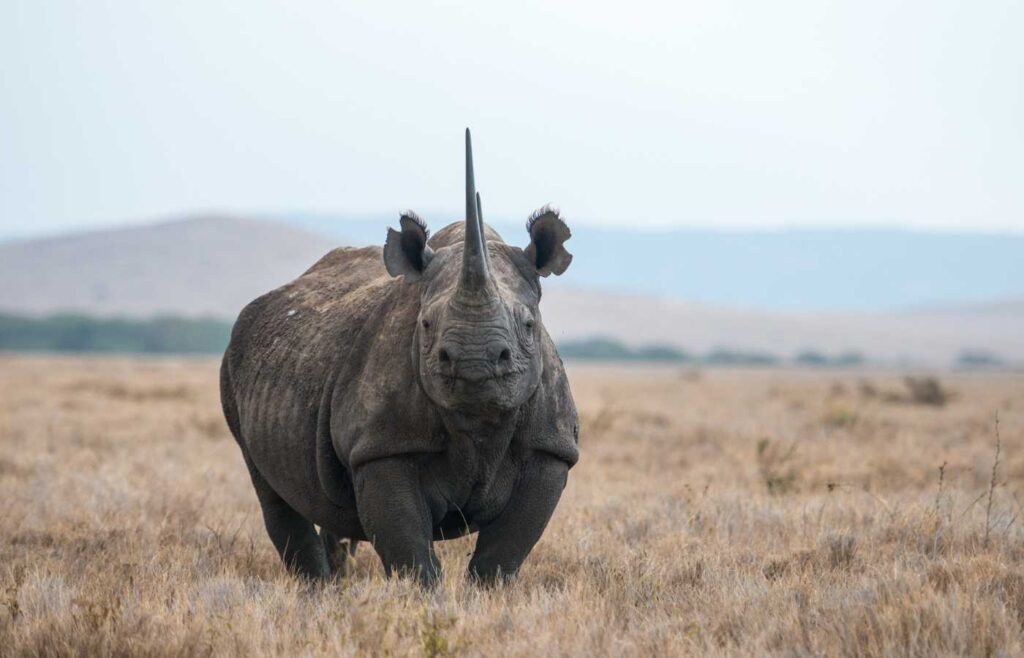
- Adult males can measure up to 13 feet long and 5 feet 9 inches tall. (Source: natgeokids.com) A rhino’s large head head can be 2.5 feet long and 1 foot wide! (Source: a-z-animal.com)
SPEED
- Rhinos can run up to 34 miles per hour. Better get out of the way! (Source: natgeokids.com)
Did you know that cheetahs are even faster? Explore their incredible speed in our Cheetah Facts for Kids article.
LIFESPAN
- A rhino’s lifespan is 35-50 years depending on the species. (Source: natgeokids.com)
SPECIES
- The word rhinoceros comes from Greek, and it means “nose horn”. (Source: natgeokids.com) Many other animals have rhinoceros as part of their names, including the rhinoceros auklet, rhinoceros beetle, rhinoceros chameleon, rhinoceros cockroach, rhinoceros fish, rhinoceros hornbill, rhinoceros iguana, rhinoceros rat snake, rhino shrimp, and rhinoceros viper. All of them have some type of horn on their noses. (rhinos.org)
- There are five species of rhinos in the world: the Black Rhino and White Rhino who live in Africa, and the Greater One-Horned Rhino, the Sumatran Rhino, and the Javan Rhino who live in Asia. (Source: www.wwf.org.uk)

- The Sumatran Rhinoceros is the oldest of the living rhinos. It appeared 15 million years ago, and its closest relative is the extinct woolly rhinoceros. (Source: rhino.org)
- Rhinos are part of a group of mammals called “odd-toed ungulates”, meaning they have an odd number of toes on their feet.
HABITAT
- Rhinos mostly live in grassy plains, rainforests, and swamps in Africa and Asia. (Source: natgeokids.com) South Africa accounts for about half of the total Black Rhino population on the African continent and is home to the world’s largest population of White Rhinos.
Similar to rhinos, Emperor Penguins thrive in specific habitats. Learn about their unique lives in our Emperor Penguin Facts for Kids.
ENDANGERMENT
- Over 7,100 African Rhinos have been killed by illegal hunting in the last 10 years. Poachers use tranquilizing darts and remove the horns with chainsaws. The rhino often bleeds to death. (Source: www.wwf.org.uk) Their horns are ground up to be used as medicine, weapons, or as a status symbol, even though this is illegal. (Source: www.wwf.org.uk)
- The Sumatran Rhinoceros, Javan Rhinoceros, and Black Rhinoceros are listed as “critically endangered”. (Source: www.wwf.org.uk)
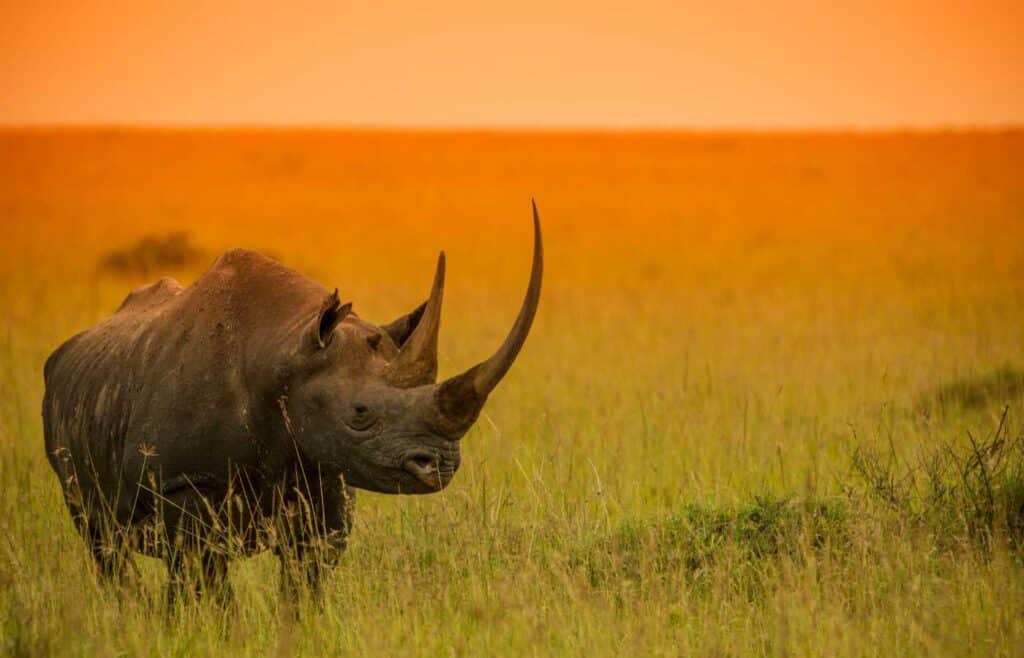
- There are an estimated 76 Javan Rhinos and 34-47 Sumatran rhinos left on Earth. They are truly under threat of extinction in the wild. (Source: www.wwf.org.uk)
- There is at least a 50% chance that these species could become extinct sometime this century, due to illegal poaching and habitat loss (Source: rhinos.org)
- There are only 2 remaining Northern White Rhinos and they are both females. (Source: a-z-animals.com)
- Javan Rhinos are only found at Ujung Kulon National Park in Indonesia. An active volcano is located 31 miles away from the park, and a devastating tsunami is predicted to occur there within the next 100 years. (Source: www.wwf.org.uk)
- There are an estimated 15,942 White Rhinos left, and they are classified as “near threatened”. (Source: www.wwf.org.uk)
- There are thought to be 4,014 Greater One-Horned Rhinos left in the wild, and their status is “vulnerable”. (Source: www.wwf.org.uk)
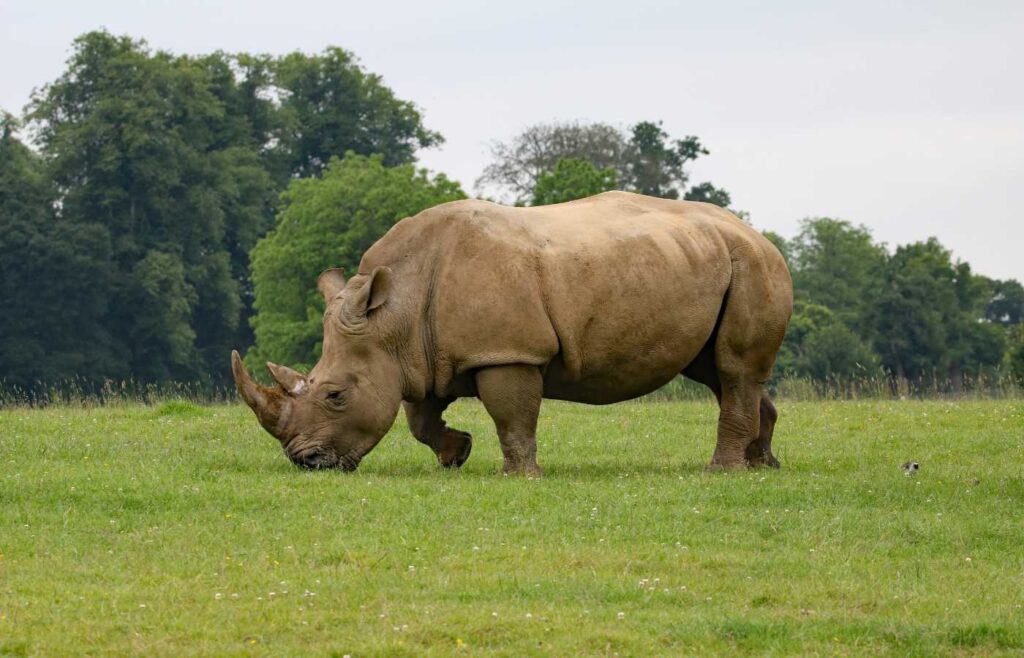
- Rhinos have no natural predators. This is likely due to their size, strong horns, and thick skin. (Source: natgeokids.com) However, lions, tigers, leopards, hyenas, wild dogs, and crocodiles can sometimes kill young rhino calves. (Source: rhino.org) Humans are the biggest threat to rhinos.
Sadly, many other species, like white tigers, are endangered too. Read more in our White Tiger Facts for Kids to understand their plight and conservation efforts.
APPEARANCE
- Black and White Rhinos are actually grey. The White Rhinoceros got its name from the Afrikaans word for wide (“wyd) which referred to its wide, square lip. Early English explorer thought they were saying “White” and so they named them White Rhinos, and named the other Black Rhino to differentiate. (Source: www.wwf.org.uk)
- The only hair on a rhinoceroses is at the tip of the tail and on the ears.(Source: kids.britannica.com)
FAMILY GROUP
- A male rhino is called a “Bull”. (Source: www.wwf.org.uk)
- A female rhinoceros is called a “Cow”. (Source: www.wwf.org.uk)
- Baby rhinos are called “calves”. (Source: www.wwf.org.uk)
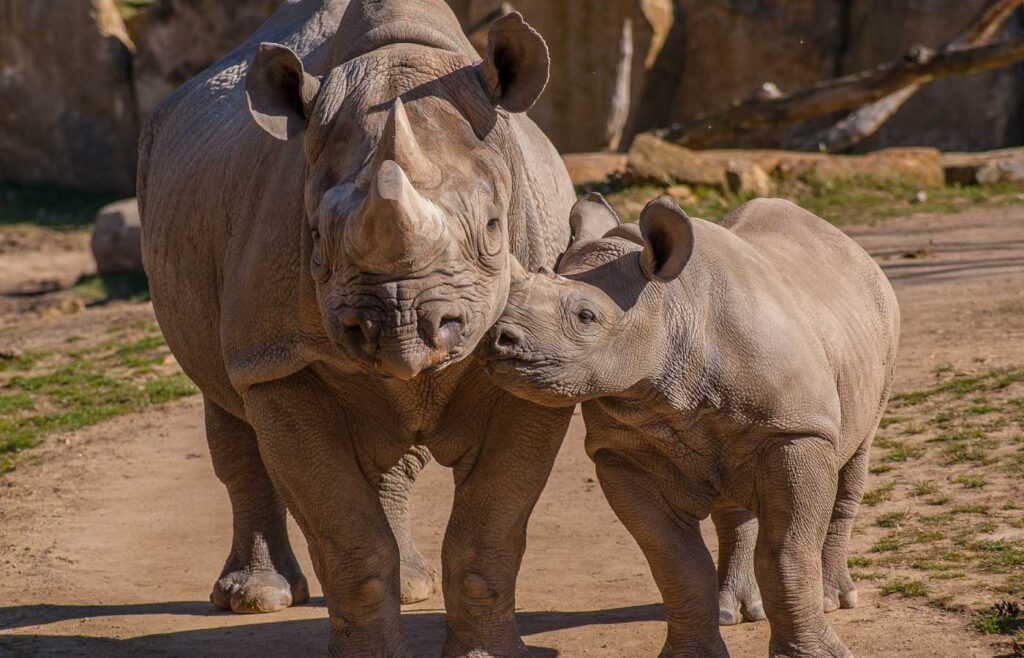
- Rhino pregnancies last 15 – 16 months. The only animal with a longer gestation period is the elephant, who carries a fetus for close to 2 years. (Source: rhino.org)
- Young rhinos usually stay with their mothers until a sibling is born. By then they’re generally over two years old, almost fully grown, and can live on their own. (Source: kids.nationalgeographic.com)
- Most wild rhino calves never meet their fathers. After mating, adult male and female rhinos typically go their separate ways. (Source: rhino.org)
- Adult rhinos are mostly solitary and avoid each other. Female rhinos are more social than males. (Source: natgeokids.com)
- Males are solitary and territorial. They mark their area of land with poop. Each individual rhino’s dung smells unique. (Source: natgeokids.com)
- A group of rhinos is called a “Crash”. The white rhino in particular form crashes usually made up of a female and her calves or adult females. (Source: natgeokids.com)
HORNS
- Rhino horns are made of the same material as fingernails, called keratin. (Source: www.wwf.org.uk)
- Javan and Greater One-Horned Rhinos only have one horn, and all of the other species have two horns. The front horn is usually much larger than the inner horn. (Source: www.wwf.org.uk)
- Rhino horns grow continuously during a rhino’s lifetime. (Source: www.wwf.org.uk)
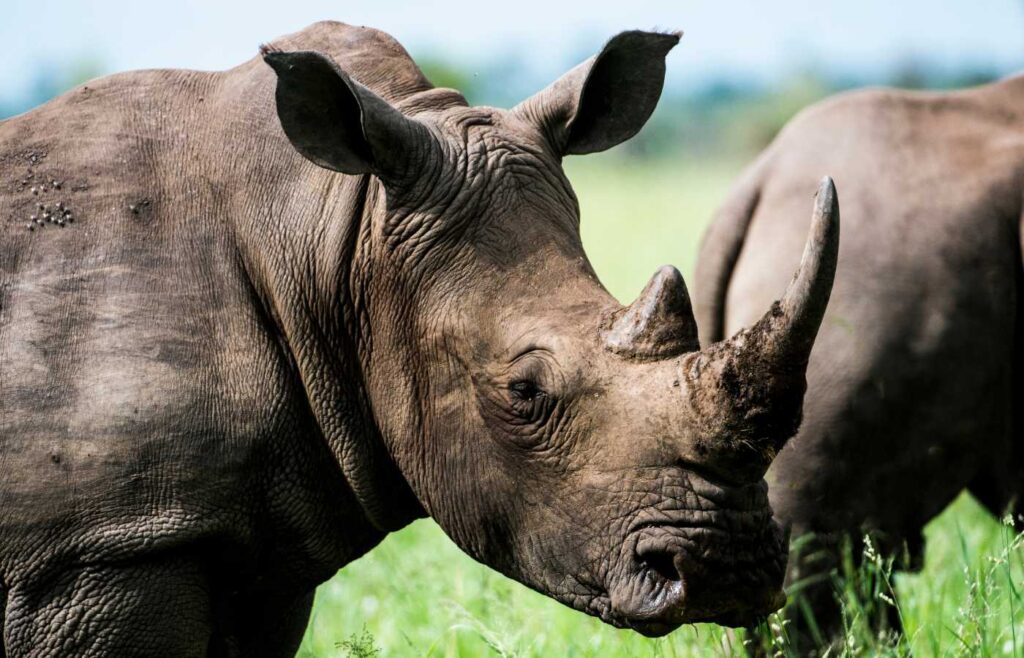
- The White Rhino’s horn can grow 7 centimeters every year. (Source: www.wwf.org.uk)
- The longest White Rhino horn measured 4 feet, 9 inches! (Source: www.wwf.org.uk)
- Their horn can grow back just like a finger nail. (Source: kids.nationalgeographic.com)
- Black rhinos use the bigger of the two horns on their noses as weapons in a fight. (Source: kids.nationalgeographic.com)
- Greater One-Horned Rhinos use their teeth – not their horns – for defense. It attacks with long, sharp incisors and canine teeth on the lower jaw.
- Mother rhinos use their large horns to protect their babies from predators such as lions, crocodiles, and hyenas. (Source: kids.nationalgeographic.com)
SENSES
- Rhinos have terrible vision. They have such poor eyesight can’t see a person standing 100 feet away. (Source: natgeokids.com)
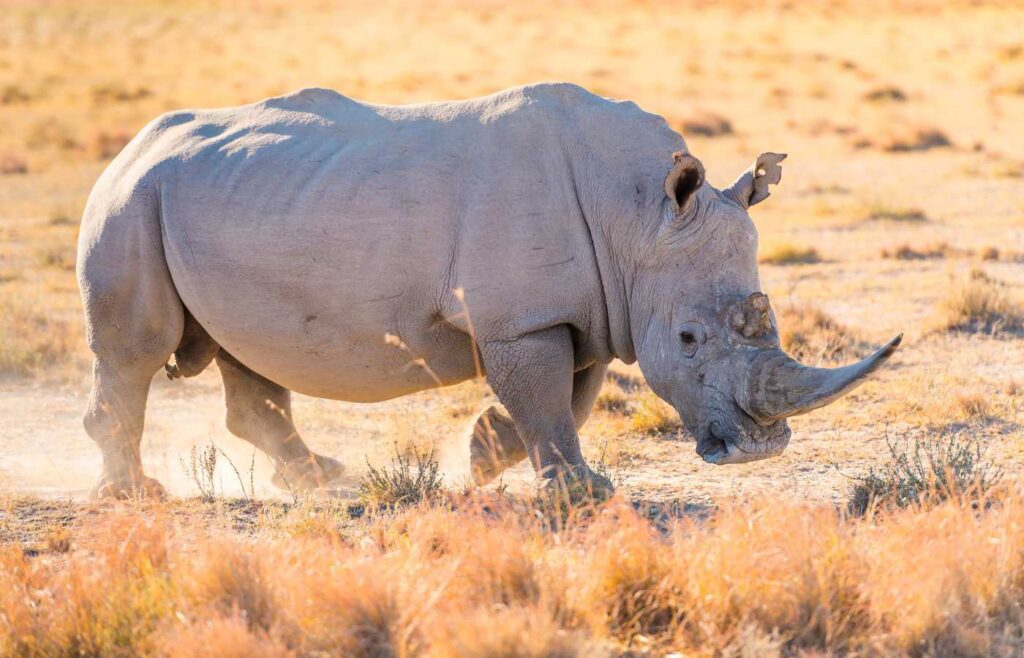
- Rhinos rely mostly on their strong sense of smell. (Source: www.wwf.org.uk)
COMMUNICATION
- Rhinos communicate with each other by growling and trumpeting. They snort when they’re angry, make sneezing sounds to sound an alarm, scream when they are scared, and make a sound like “mmwonk” when they are feeling relaxed. (Source: www.wwf.org.uk)
Their unique sounds remind us of other fascinating animal communication styles. For example, monkeys also have complex vocalizations. Learn more in our Monkey Facts For Kids article.
DUNG
- An adult white rhino can produce as much as 50 pounds of dung per day! (Source: rhino.org)
- Each Rhino’s dung smells unique. It can tell if a rhino is young or old, male or female, and more.
- Rhinos communicate through their poop and urine. They know what other rhinos are in the area because they can smell their waste. (Source: www.wwf.org.uk)
BEHAVIOR
- Rhinos roll around the mud to keep themselves cool and protect themselves from insects and parasites. (Source: www.wwf.org.uk) Similarly, wolves have unique survival behaviors. Discover them in our Grey Wolf Facts for Kids.
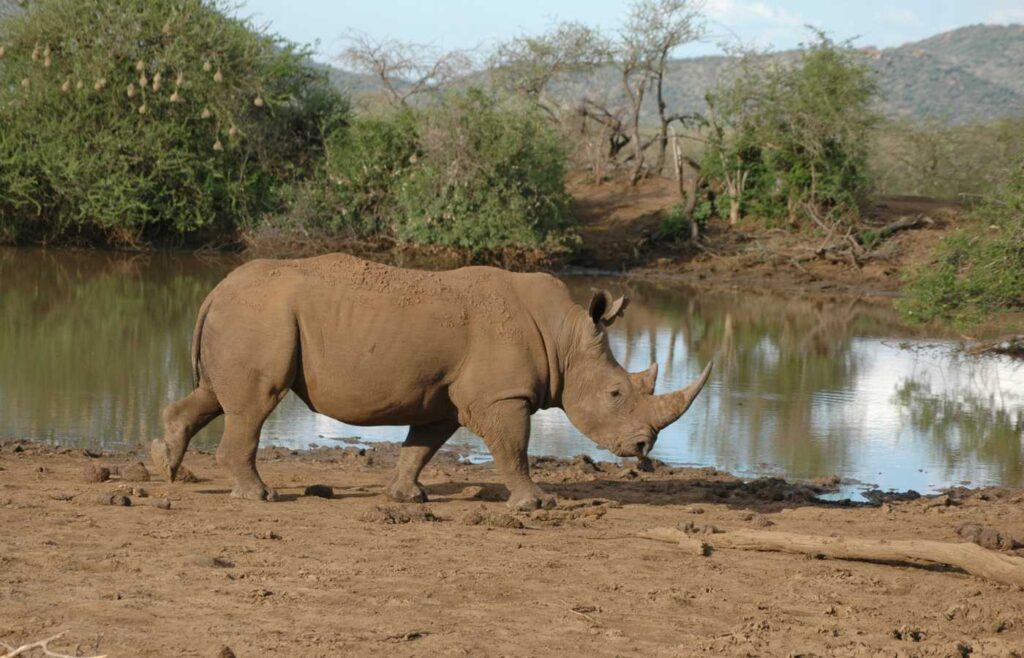
- Some rhinos can swim very well. Asian rhinos are good swimmers and can cross rivers easily. African rhinos are not good swimmers and can drown in deep water. (Source: www.wwf.org.uk)
- Rhinos are easily scared. When they feet threatened, their instinct is to charge. Sometimes they accidentally charge an object like a tree. (Source: natgeokids.com)
FOOD
- Rhinos are herbivores, eating mostly grass and leaves. They don’t eat meat. (Source: www.wwf.org.uk)
- White rhinos must eat up to 120 pounds of grass per day to sustain their huge bodies. (Source: marylandzoo.org)
MISC.
- Rhinos are often seen with Oxpeckers, also known as “tick birds” perched on their back. They have a symbiotic relationship with these birds, which means they help each other. The birds live off the insects that live in the rhino’s thick skin, and the birds’ loud cries also help alert the rhino of potential danger. (Source: natgeokids.com)
- Rhinos have relatively small brains for their size, but they are intelligent animals. (Source: savetherhino.org)
- A fossil skull first thought to be that of a dragon was discovered in souther Austria, but it turned out to be from an extinct woolly rhinoceros of the last Ice Age. (Source: rhino.com)
Frequently Asked Questions About Rhinos
Are rhinos extinct?
Some species of rhinos are extinct, and others are still alive but endangered. There are only 2 remaining Northern White Rhinos and they are both females. (Source: a-z-animals.com)
There are an estimated 76 Javan Rhinos and 34-47 Sumatran rhinos left on Earth. They are truly under threat of extinction in the wild. (Source: www.wwf.org.uk)
Are rhinos endangered?
Yes, the rhinoceros species is an endangered species due to illegal poaching and loss of habitat.
Over 7,100 African Rhinos have been killed by illegal hunting in the last 10 years. Poachers use tranquilizing darts and remove the horns with chainsaws. The rhino often bleeds to death. (Source: www.wwf.org.uk) Their horns are ground up to be used as medicine, weapons, or as a status symbol, even though this is illegal. (Source: www.wwf.org.uk)

The Sumatran Rhinoceros, Javan Rhinoceros, and Black Rhinoceros are listed as “critically endangered”. (Source: www.wwf.org.uk)
There is at least a 50% chance that these species could become extinct sometime this century, due to illegal poaching and habitat loss (Source: rhinos.org)
Javan Rhinos are only found at Ujung Kulon National Park in Indonesia. An active volcano is located 31 miles away from the park, and a devastating tsunami is predicted to occur there within the next 100 years. (Source: www.wwf.org.uk)
There are an estimated 15,942 White Rhinos left, and they are classified as “near threatened”. (Source: www.wwf.org.uk)
There are thought to be 4,014 Greater One-Horned Rhinos left in the wild, and their status is “vulnerable”. (Source: www.wwf.org.uk)
Can rhinos swim?
Yes, some rhinos can swim very well. Asian rhinos are good swimmers and can cross rivers easily. African rhinos are not good swimmers and can drown in deep water.
Can rhinos jump?
No, rhinos cannot jump. There are a few other mammals that cannot jump either, including elephants, sloths, and hippos. They are too heavy.
Can rhinos see?
Rhinos have terrible vision. They have such poor eyesight can’t see a person standing 100 feet away. (Source: natgeokids.com) Rhinos rely mostly on their strong sense of smell. (Source: www.wwf.org.uk)
Are rhinos herbivores?
Yes, rhinos are herbivores, eating mostly grass and leaves. They don’t eat meat. (Source: www.wwf.org.uk) White rhinos must eat up to 120 pounds of grass per day to sustain their huge bodies. (Source: marylandzoo.org)
Do rhinos eat meat?
No, rhinos are herbivores, eating mostly grass and leaves. They don’t eat meat. (Source: www.wwf.org.uk) White rhinos must eat up to 120 pounds of grass per day to sustain their huge bodies. (Source: marylandzoo.org)
Where do rhinos live?
Rhinos mostly live in grassy plains, rainforests, and swamps in Africa and Asia. (Source: natgeokids.com) South Africa accounts for about half of the total Black Rhino population on the African continent and is home to the world’s largest population of White Rhinos.
What do rhinos eat?
Rhinos are herbivores, eating mostly grass and leaves. They don’t eat meat. (Source: www.wwf.org.uk) White rhinos must eat up to 120 pounds of grass per day to sustain their huge bodies. (Source: marylandzoo.org)
What is rhino horn made of?
Rhino horns are made of keratin, the same material as fingernails and hair. Rhino horns grow continuously during a rhino’s lifetime. The White Rhino’s horn can grow 7 centimeters every year. The longest White Rhino horn measured 4 feet, 9 inches! (Source: www.wwf.org.uk). Their horn can grow back just like a finger nail. (Source: kids.nationalgeographic.com)
What is rhino horn used for?
Over 7,100 African Rhinos have been killed by illegal hunting in the last 10 years. Their horns are ground up to be used as medicine to “cure” a number of diseases, weapons like specialized daggers, or as a status symbol, even though this is illegal. (Source: www.wwf.org.uk)
What do rhinos use their horns for?
Rhinos use their horns to for digging, foraging, breaking branches, and protecting their babies from predators such as lions, crocodiles, and hyenas. (Source: kids.nationalgeographic.com) Greater One-Horned Rhinos use their teeth – not their horns – for defense. It attacks with long, sharp incisors and canine teeth on the lower jaw.
To help rhinos and support conservation efforts, head to rhinos.org.
Related posts
- 50 Mind-Blowing Monkey Facts Your Kids Will Love
- 100 Mind-Blowing Facts About Elephants
- Emperor Penguin Facts for Kids
- White Tiger Facts for Kids
- Cheetah Facts for Kids
- Grey Wolf Facts for Kids
Calie Herbst, Editor-in-Chief of Milwaukee With Kids, has spent over a decade combining her experiences as a parent of three to create a hub for Milwaukee’s family adventures.
Her decade-long teaching career in Milwaukee Public Schools and academic background, including a Master’s in Teaching from Marquette University and dual B.A.s in Sociology and Spanish from the University of Wisconsin – Madison, fuel her passion for inclusive and engaging family content.
Calie is also a recognized voice in local media, contributing to WISN Channel 12 News, WTMJ Wisconsin Morning News, Fox 6’s Real Milwaukee, and B93.3.
Discover more about Calie’s journey and editorial approach on her About Page and Editorial Policy Page.


